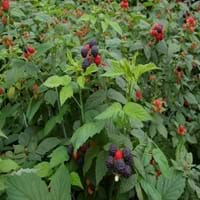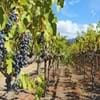About Black Raspberry and Meadow Saffron
Life Span
Perennial
Perennial
Type
Fruit
Bulb or Corm or Tuber
Origin
Hybrid origin
Hybrid origin
Types
Rubus leucodermis, Rubus occidentalis, Rubus coreanus
boissieri , cupanii , hungaricum , kesselringii
Number of Varieties
Not Available
Habitat
Cold Regions
Temperate Regions
USDA Hardiness Zone
5-8
Not Available
AHS Heat Zone
8-1
Not Available
Sunset Zone
Not Available
21,22
Habit
Arching/Fountain-shaped
Clump-Forming
Flower Color
White
Purple, Violet
Flower Color Modifier
Bicolor
Bicolor
Fruit Color
Black
Not Available
Leaf Color in Spring
Green
Green
Leaf Color in Summer
Green
Light Green
Leaf Color in Fall
Green
Several shades of Green
Leaf Color in Winter
Light Green
Light Green
Leaf Shape
Oval
Long Linear
Plant Season
Summer
Spring, Fall
Sunlight
Full Sun
Full Sun, Partial Sun
Type of Soil
Loam, Sand
Loam
The pH of Soil
Acidic, Neutral
Acidic, Neutral
Soil Drainage
Well drained
Well drained
Bloom Time
Early Spring, Spring
Late Summer, Early Fall
Tolerances
Drought
Drought
Where to Plant?
Ground
Ground
How to Plant?
Cuttings, Root Division
Divison, From bulbs, Seedlings
Plant Maintenance
Medium
Medium
Watering Requirements
Medium
Keep ground moist
In Summer
Lots of watering
Lots of watering
In Spring
Moderate
Moderate
In Winter
Average Water
Average Water
Soil pH
Acidic, Neutral
Acidic, Neutral
Soil Type
Loam, Sand
Loam
Soil Drainage Capacity
Well drained
Well drained
Sun Exposure
Full Sun
Full Sun, Partial Sun
Pruning
Prune in fall, Remove damaged leaves, Remove dead branches, Remove dead leaves, Remove dead or diseased plant parts
no pruning required
Fertilizers
All-Purpose Liquid Fertilizer, Apply 10-10-10 amount
All-Purpose Liquid Fertilizer
Pests and Diseases
Red blotch
Dry root rot, Pest Free
Plant Tolerance
Drought
Drought
Flower Petal Number
Single
Single
Foliage Texture
Medium
Coarse
Foliage Sheen
Matte
Glossy
Attracts
Birds, Butterflies
Whiteflies
Allergy
cramps, Diarrhea, Itchiness, Runny nose, Skin rash, sneezing, Swollen Lips, Tingly mouth, Vomiting, Watery eyes
Poisonous to grazing animals
Aesthetic Uses
Not Used For Aesthetic Purpose
along a porch, deck or patio, Borders, Mixed Border, small hedge
Beauty Benefits
Good for skin
No Beauty Benefits
Environmental Uses
Air purification, Food for birds, Food for insects, Nesting sites for birds, Shadow Tree, Windbreak
Air purification
Medicinal Uses
anti-cancer, Astringent, Diuretic, Febrifuge, Stomachic, Tonic
anti rheumatic, cathartic
Part of Plant Used
Bark, Fruits, Leaves
Root
Other Uses
Used As Food
Showy Purposes
Used As Indoor Plant
No
No
Used As Outdoor Plant
Yes
Yes
Garden Design
Edible, Fruit / Fruit Tree
Container, Cutflower, Foundation, Lawns and Turf, Mixed Border
Botanical Name
RUBUS 'Jewel'
COLCHICUM 'Lilac Wonder'
Common Name
Black Raspberry
Hybrid Autumn Crocus, Hybrid Meadow Saffron
In Hindi
Black Raspberry Tree
meadow saffron
In German
Schwarze Himbeere Baum
Herbstzeitlose
In French
Noir Arbre Framboise
Colchique d'automne
In Spanish
Negro del árbol de la frambuesa
Estado de conservación
In Greek
Μαύρο Raspberry Δέντρο
meadow saffron
In Portuguese
Árvore framboesa Preto
Colchicum autumnale
In Polish
Czarny Raspberry Drzewo
Colchicum autumnale
In Latin
Niger IDAEUS ligno
autumnale
Phylum
Magnoliophyta
Tracheophyta
Class
Magnoliopsida
Magnoliopsida
Family
Rosaceae
Liliaceae
Clade
Angiosperms, Eudicots, Rosids
Angiosperms, Monocots
Tribe
Not Available
Not Available
Subfamily
Rosoideae
Not Available
Number of Species
Not Available
Not Available
Properties of Black Raspberry and Meadow Saffron
Wondering what are the properties of Black Raspberry and Meadow Saffron? We provide you with everything About Black Raspberry and Meadow Saffron. Black Raspberry has thorns and Meadow Saffron doesn't have thorns. Also Black Raspberry does not have fragrant flowers. Black Raspberry has allergic reactions like cramps, Diarrhea, Itchiness, Runny nose, Skin rash, sneezing, Swollen Lips, Tingly mouth, Vomiting and Watery eyes and Meadow Saffron has allergic reactions like cramps, Diarrhea, Itchiness, Runny nose, Skin rash, sneezing, Swollen Lips, Tingly mouth, Vomiting and Watery eyes. Compare all the properties and characteristics of these two plants. Find out which of these plant can be used as indoor plant. If you are interested to decorate your house and garden, find out aesthetic uses, compare them and select the plant which will beautify your surrounding. Along with beautification, try comparing medicinal and edible uses of Black Raspberry and Meadow Saffron and you can choose the plant having best and most benefits.
Season and Care of Black Raspberry and Meadow Saffron
Season and care of Black Raspberry and Meadow Saffron is important to know. While considering everything about Black Raspberry and Meadow Saffron Care, growing season is an essential factor. Black Raspberry season is Summer and Meadow Saffron season is Summer. The type of soil for Black Raspberry is Loam, Sand and for Meadow Saffron is Loam while the PH of soil for Black Raspberry is Acidic, Neutral and for Meadow Saffron is Acidic, Neutral.
Black Raspberry and Meadow Saffron Physical Information
Black Raspberry and Meadow Saffron physical information is very important for comparison. Black Raspberry height is 182.88 cm and width 30.48 cm whereas Meadow Saffron height is 12.70 cm and width 20.30 cm. The color specification of Black Raspberry and Meadow Saffron are as follows:
Black Raspberry flower color: White
Black Raspberry leaf color: Green
Meadow Saffron flower color: Purple and Violet
- Meadow Saffron leaf color: Green
Care of Black Raspberry and Meadow Saffron
Care of Black Raspberry and Meadow Saffron include pruning, fertilizers, watering etc. Black Raspberry pruning is done Prune in fall, Remove damaged leaves, Remove dead branches, Remove dead leaves and Remove dead or diseased plant parts and Meadow Saffron pruning is done no pruning required. In summer Black Raspberry needs Lots of watering and in winter, it needs Average Water. Whereas, in summer Meadow Saffron needs Lots of watering and in winter, it needs Average Water.





